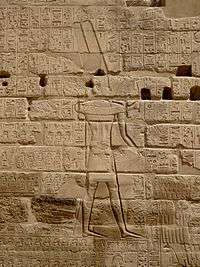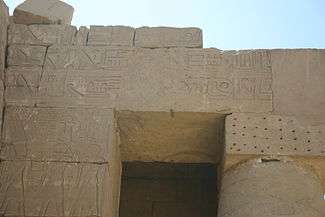Shishak
Shishak, Shishaq or Susac (Hebrew: שישק, romanized: s̀ys̀q, Tiberian: [ʃiʃaq], Ancient Greek: Σουσακίμ, romanized: Sousakim) was, according to the Hebrew Bible, an Egyptian pharaoh who sacked Jerusalem in the 10th century BCE. He is usually identified with the pharaoh Shoshenq I.[1]
Biblical narrative

Shishak's campaign against the Kingdom of Judah and his sack of Jerusalem are recounted in the Hebrew Bible, in 1 Kings 14:25 and 2 Chronicles 12:1-12. According to these accounts, Shishak had provided refuge to Jeroboam during the later years of Solomon's reign, and upon Solomon's death, Jeroboam became king of the tribes in the north, which separated from Judah to become the Kingdom of Israel. In the fifth year of Rehoboam's reign, commonly dated ca. 926 BCE,[2] Shishak swept through Judah with a powerful army of 60,000 horsemen and 1,200 chariots, in support of Jeroboam. According to 2 Chronicles 12:3, he was supported by the Lubim (Libyans), the Sukkiim, and the Kushites ("Ethiopians" in the Septuagint).
Shishak took away treasures of the Temple of Yahweh and the king's house, as well as shields of gold which Solomon had made;[3] Rehoboam replaced them with brass ones.
According to Second Chronicles,
When Shishak king of Egypt attacked Jerusalem, he carried off the treasures of the temple of the Lord and the treasures of the royal palace. He took everything, including the gold shields Solomon had made.
Flavius Josephus in Antiquities of the Jews adds to this a contingent of 400,000 infantrymen. According to Josephus, his army met with no resistance throughout the campaign, taking Rehoboam's most fortified cities "without fighting". Finally, he conquered Jerusalem without resistance, because "Rehoboam was afraid." Shishak did not destroy Jerusalem, but forced King Rehoboam of Judah to strip the Temple and his treasury of their gold and movable treasures.[4]
Shushak was also related by marriage to Jeroboam. The wife of Jeroboam is unnamed in the Masoretic Text, but according to the Septuagint, she was an Egyptian princess called Ano:
Shishak's name
Texts written in various ancient languages seem to indicate that the first vowel was both long and round, and the final vowel was short. For example, the name is written in the Hebrew Bible as שישק [ʃiːʃaq]. The variant readings in Hebrew, which are due to confusion between the letters < י > Yod and < ו > Vav that are particularly common in the Masoretic Text, indicate that the first vowel was long in pronunciation. The Septuagint uses Σουσακιμ [susakim], derived from the marginal reading שושק [ʃuːʃaq] of Hebrew. This indicates during the 2nd century BC Hebrew-speakers or Alexandrian Greek-speakers pronounced the name with an initial long close back rounded vowel [u].
Shishak identified as Pharaoh Shoshenq I
In the very early years after the decipherment of Egyptian hieroglyphs, on chronological, historical, and linguistic grounds, nearly all Egyptologists identified Shishak with Shoshenq I of the 22nd dynasty, who invaded Canaan following the Battle of Bitter Lakes.[1] This position was maintained by most scholars ever since, and is still the majority position. The fact that Shoshenq I left behind "explicit records of a campaign into Canaan (scenes; a long list of Canaanite place-names from the Negev to Galilee; stelae), including a stela [found] at Megiddo" supports the traditional interpretation.[6][7][8] There are however some notable exceptions, such as Jerusalem itself which is not mentioned in any of his campaign records.[6][7][8] This would seem contradictory to the biblical account which explicitly mentions Jerusalem. Nevertheless, a common variant of Shoshenq's name omits its 'n' glyphs, resulting in a pronunciation like, "Shoshek".[9]
The Bubastite Portal

The Bubastite Portal, a relief discovered at Karnak, in Upper Egypt, and similar reliefs on the walls of a small temple of Amun at el-Hibeh, shows Pharaoh Shoshenq I holding in his hand a bound group of prisoners. The names of captured towns are located primarily in the territory of the kingdom of Israel (including Megiddo), with a few listed in the Negeb, and perhaps Philistia. Some of these include a few of the towns that Rehoboam had fortified according to Chronicles.[10]
The portal is generally believed to record a historical campaign of Sheshonq I in Judah, but it makes no mention of Jerusalem being sacked, nor of Rehoboam or Jeroboam. Various explanations of this omission of Jerusalem have been proposed: its name may have been erased, the list may have been copied from an older pharaoh's list of conquests, or Rehoboam's ransoming the city (as described in the Second Book of Chronicles[11]) would have saved it from being listed.
Critical questions
It has been claimed that the numbers of Egyptian soldiers given in Chronicles can be "safely ignored as impossible" on Egyptological grounds; similarly, the numbers of chariots reported in 2 Chronicles is likely exaggerated by a factor of ten—leading 60,000 horses through the Sinai and Negev would have been logistically impossible, and no evidence of Egyptian cavalry exists from before the 27th Dynasty.[12] The treasures taken by Shishak are also highly unlikely. Firstly, no United Monarchy of Israel and Judah occurs in Shoshenq's list of conquered enemies; second, the material culture of 10th century Jerusalem and surroundings is alleged by some scholars such as Israel Finkelstein to have been too primitive to allow for any treasure that an Egyptian pharaoh would have been interested in. Finkelstein concludes that the looting narrative "should probably be seen as a theological construct rather than as historical references".[2]:175
Fringe theories
Other identifications of Shishak have been put forward by chronological revisionists, arguing that Shoshenq's account does not match the Biblical account very closely, but these are considered fringe theories. In his book Ages in Chaos, Immanuel Velikovsky identified him with Thutmose III of the 18th dynasty. More recently, David Rohl's New Chronology identified him with Ramesses II of the 19th dynasty, and Peter James has identified him with Ramesses III of the 20th dynasty.
In popular culture
Shishak is mentioned in Steven Spielberg's action-adventure film Raiders of the Lost Ark as the pharaoh who seized the Ark of the Covenant from the Temple of Solomon during his raids on Jerusalem and hid it in the Well of Souls in Tanis.
References
- Troy Leiland Sagrillo. 2015. "Shoshenq I and biblical Šîšaq: A philological defense of their traditional equation". In Solomon and Shishak: Current perspectives from archaeology, epigraphy, history and chronology; proceedings of the third BICANE colloquium held at Sidney Sussex College, Cambridge 26–27 March 2011, edited by Peter J. James, Peter G. van der Veen, and Robert M. Porter. British Archaeological Reports (International Series) 2732. Oxford: Archaeopress. 61–81.
- Finkelstein, Israel (2006). "The Last Labayu: King Saul and the Expansion of the First North Israelite Territorial Entity". In Amit, Yairah; Ben Zvi, Ehud; Finkelstein, Israel; et al. (eds.). Essays on Ancient Israel in Its Near Eastern Context: A Tribute to Nadav Naʼaman. Eisenbrauns. pp. 171 ff. ISBN 9781575061283.
- 1 Kings 14:25; 2 Chronicles 12:1-12
- Antiquities of the Jews - Book VIII, Chapter X.
- 1 Kings 12:24e, New English Translation of the Septuagint
- K.A. Kitchen, On the Reliability of the Old Testament, William Eerdmans & Co, 2003. pp. 10, 32–34, 607. Page 607 of Kitchen's book depicts the surviving fragment of Shoshenq I's Megiddo stela which bears this king's cartouche.
- http://www.archpark.org.il/
- 'The First Oppressors: Shishak of Egypt' - BiblicalStudies.org pg1
- von Beckerath, Jürgen (1984) Handbuch der ägyptischen Königsnamen, München: Deutscher Kunstverlag, page 257–258, 260–262, 264
- 2 Chronicles 11:5-12
- 2 Chronicles 12, 7 - 10
- Sagrillo, Troy Leiland (2012). Šîšaq’s army: 2 Chronicles 12:2–3 from an Egyptological perspective. The ancient Near East in the 12th–10th Centuries BC: Culture and history; Proc. of the international conference held at the University of Haifa, 2–5 May 2010. Alter Orient und Altes Testament: Veröffentlichungen zur Kultur und Geschichte des Alten Orients und des Alten Testaments. 392. Münster: Ugarit-Verlag. pp. 425–450.
Further reading
- Rohl, David M. (1995). Pharaohs and Kings: A Biblical Quest. New York: Crown Publishers, inc.
- Ad Thijs,'From the Lunar Eclipse of Takeloth II back to Shoshenq I and Shishak' In: P. James and P. van der Veen (eds.), Solomon and Shishak, BAR International Series 2732, Archaeopress, Oxford, 2015: pp. 42–60
- Peter van der Veen, The name Shishak, an update, JACF 10(2005), pp. 8, 42
- Peter van der Veen, 'The Name Shishaq: Shoshenq or Shyshu/q? Responding to the Critics and Assessing the Evidence ' In: P. James and P. van der Veen (eds.), Solomon and Shishak, BAR International Series 2732, Archaeopress, Oxford, 2015
- Troy Leiland Sagrillo. 2015. "Shoshenq I and biblical Šîšaq: A philological defense of their traditional equation." In Solomon and Shishak: Current perspectives from archaeology, epigraphy, history and chronology; proceedings of the third BICANE colloquium held at Sidney Sussex College, Cambridge 26–27 March 2011, edited by Peter J. James, Peter G. van der Veen, and Robert M. Porter. British Archaeological Reports (International Series) 2732. Oxford: Archaeopress. 61–81.
- Muchiki Yoshiyuki (1999). Egyptian Proper Names and Loanwords in North-West Semitic. Atlanta: Society of Biblical Literature.